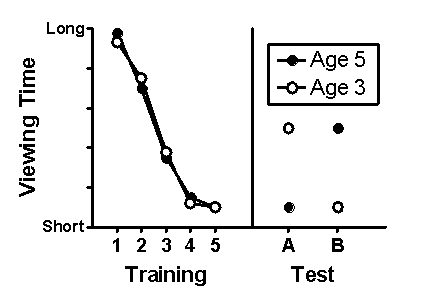Scenario I
Scenario I is based on and presents fabricated results consistent with the following study:
Kim, I. K., & Spelke, E. S. (1992) . Infants' sensitivity to effects of gravity on visual object motion. Journal of Experimental Psychology: Human Perception and Performance, 18(2) , 385-393.
Kim and Spelke (1992) investigated the extent to which infants have expectancies of gravitational effects on visual object motion. Three- and five-month-old infants repeatedly watched a video of a ball accelerating as it rolled down an incline until they spent little time actively looking at it. Subsequently, two types of test trials were conducted in randomized order. Type A test trials consisted of a ball slowing down as it rolled up an incline. Type B test trials consisted of a ball slowing down as it rolled down an incline. During all trials, the amount of time looking at each visual display was recorded. Fabricated data consistent with the major finding of this study are presented in Figure 11.1.
Figure 11.1 
-(Scenario I) Which is a true inference based on the data shown in Figure 11.1?
Definitions:
Social Positions
The status or rank that an individual holds within a society, often influenced by factors such as occupation, wealth, and family background.
African-Americans
A racial or ethnic group in the United States with ancestry from the black racial groups of Africa, historically subjected to slavery and discrimination but with a rich cultural heritage and significant contributions to American society.
Asian-Americans
Americans of Asian descent, a diverse group including individuals with origins in East Asia, Southeast Asia, or South Asia.
Dawes Severalty Act
A 1887 law aimed at assimilating Native Americans into American society by dividing tribal land into individual plots for ownership.
Q3: In the United States, teenage mothers score
Q15: A 4-year-old child with the mental age
Q17: Formal operational thinking is characterized by the
Q21: Actuarial scales on the MMPI-2-RF help detect
Q28: If a zygote has at least one
Q69: The Big Five model includes all of
Q72: Reed believes that he is much smarter
Q81: Charles Spearman's two factors of intelligence were
Q97: The period of development that begins with
Q145: The finding that homophobic men exhibit more